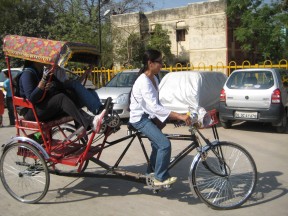When Khoj Studios, an NGO located in Delhi’s Khirkee Village, announced a day long workshop at their premises to introduce the concept of ‘augmented reality’ in art, and requested the participants to carry their own smart phones, the first reaction was of confusion. Not because one didn’t own the gadget, but for the fact that our minds, so conditioned to what mainstream art practice is all about, could not fathom how this workshop had anything to do with art.
A visit to Khoj Studios last Saturday afternoon, however, was an eye-opener. Titled One Square Augmented Mile Project(1SAM Project), the workshop explained how technology could help take art to the community. A specialised software, 1SAM has created a layer of information, images and text taken from one square mile around Khoj, which can be seen and discovered, using augmented reality applications on smart phones. After introducing the 1SAM project through a presentation, participants in the workshop were taken for a walk within one mile area around Khoj, who took their own pictures to later upload them, adding a new layer of information to the existing set of 40 images Khoj had started with.
But to begin with, let’s explain what 1SAM software is all about. Developed by BlueAnt Digital Intelligence (a company run by young techies), 1SAM uses augmented reality technology, which adds information to what your mobile device sees in the real world. This information could be just about anything, it could show you all the shops, restaurants, offices around you and function as a directory. It could place models of old buildings that are no longer there or models of new buildings that are to be built, so that you can see exactly what they looked like or will look like when they are built. Almost any application that has information, sound, video, images, text and even 3D models can be built using this concept.
The technology uses Layar – an augmented reality browser, which lets you add images, text, animations and 3D models to what your camera sees. It’s like firefox, chrome or internet explorer (web browser) for augmented reality. In order to access 1SAM, the user needs to have a smart-phone, which is either Android based or is an iPhone.
In the context of Khoj, BlueAnt has developed this software to show Khoj’s work around Khirkee and to let people leave their pictorial memories of the one square mile around Khoj. Once we got back after clicking images around the area, and uploaded them to 1SAM, we realised the project is designed to engage the users with new media practice through the interface of art. For people, it’s a way to share their most cherished moments with other people.
Says Pooja Sood, Director, Khoj Studios: “We feel, that over time, we will have images from a plethora of people, sharing their memories of that square mile, with other people. By getting the community involved, the project allows opening of new modes of learning, exchanging information and discovering through technological intervention.”
In fact, ISAM is not only a project using Khoj archives, but a project curating the Khoj archives. By sharing the archives, Khoj is engaging in a larger conversation of urbanism, ecology and governance of this area.
Adds Sood: “Khoj has always aimed to create an alternative forum for
experimentation and exchange within contemporary art practice. In 14 years, Khoj has created an unconventional link between art and other disciplines like science, technology and fashion. By re-looking at our archives in a different context provided by this project, we begin to start a conversation with our practice. A cycle – of archives creating a discursive space that feed programs – is created.”
Khoj, in fact, has been witness, both as a physical entity and through its art practice, to the changing face of Khirkee. A neighbourhood which was a full of migrant labour and sleepy shops till a few years ago is now teeming with shiny malls and upscale eateries.
Says Arjun Jassal of BlueAnt: “Also, Khoj has done several projects in their vicinity. By allowing people to add their images of what Khirkee now looks like, where these artworks were earlier put up, we are involving them in the growth and changing dynamics of their city. It will become a collection of not only images and text, but moments from different people taken at different times, but of the same place. It’s like when you look at the city, the city looks back at you.”
Khoj also hopes that soon this technology can be used for other practical uses as well. For instance, such a project can be used in local civic issues. By creating a layer that documents issues like that of roads, drains, streetlights etc, these problems can then be reported to the civic authorities for repair. The same technology can also be used for architectural purposes.
This is the idea of the project – to show experiences, start conversations and enter a dialogue in a fun and interactive way. It challenges the notion of knowledge existing in books and institutions, when we can clearly see how informal practices such as these can very well produce a systemic change in knowledge exchange.
Khoj has started the process and this, as Sood says, “is only the beginning” of a similar art project on a bigger scale.
Poonam Goel is a freelance journalist and has covered the arts for over 15 years. She contributes on visual arts for various newspapers, magazines and online media. More about her on Story Wallahs. Write to her @
poonamgoel2410@gmail.com






